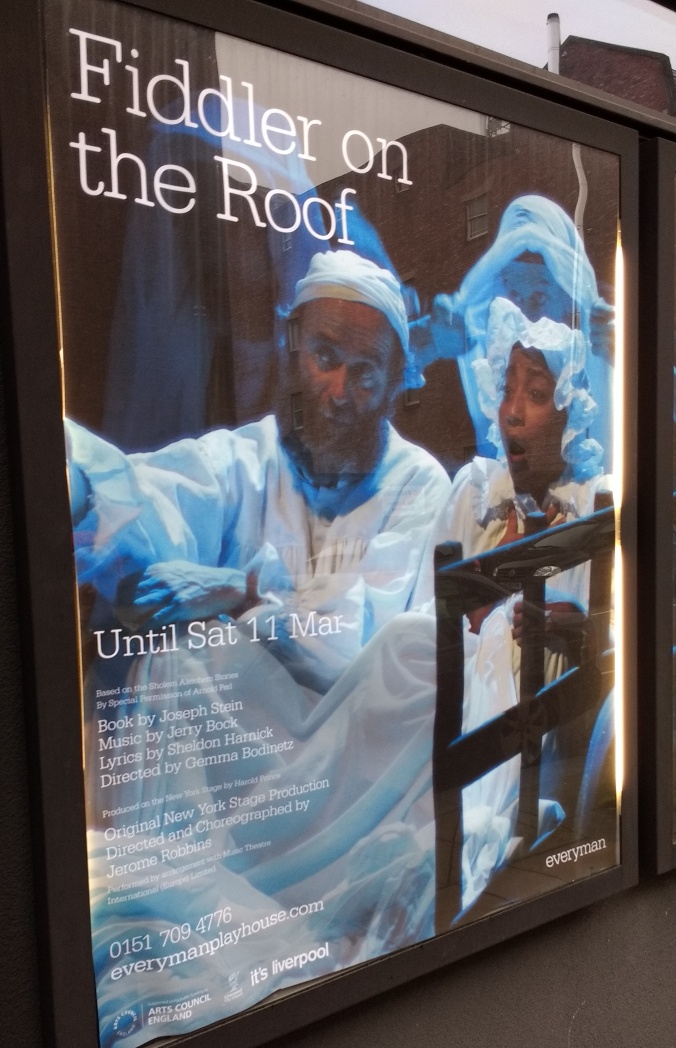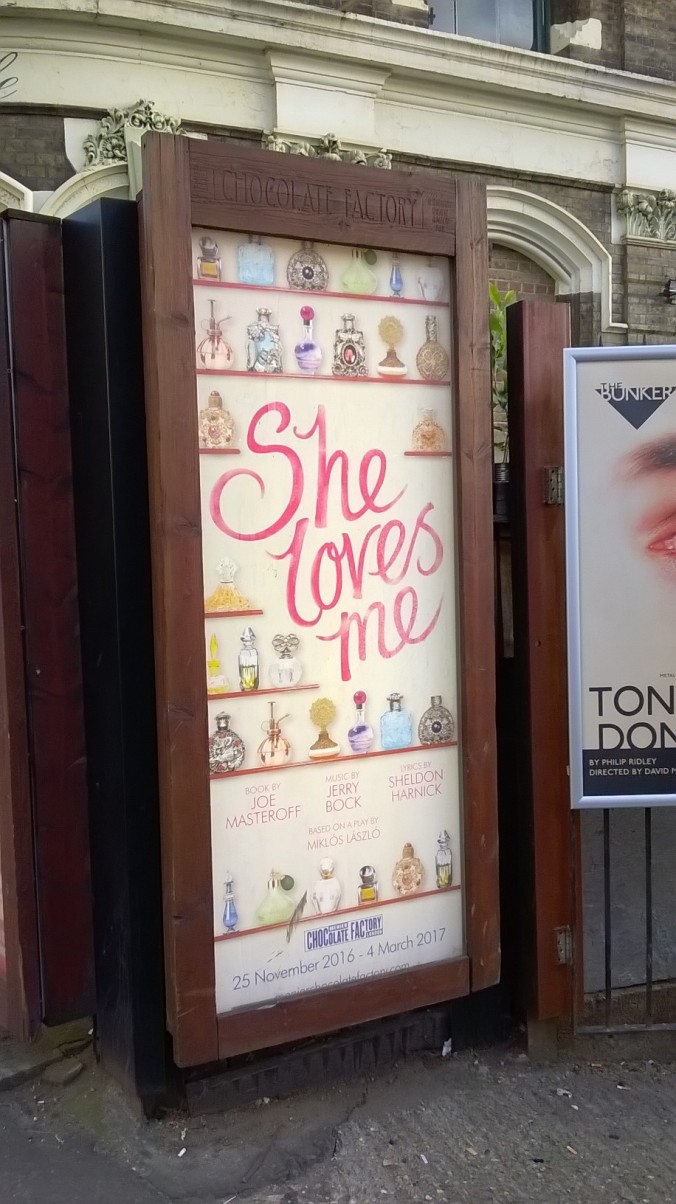
It’s an old idea, but it’s been out of fashion for so long that this possibly qualifies as innovation. For this season, instead of casting each show individually, Liverpool’s Everyman Theatre has hired a resident company of actors. All five shows in their season will be cast from the same pool of actors, and in the summer all five will play in rep for a month. Once upon a time, not all that long ago, it was relatively common for a regional theatre to hire actors on this basis; these days, it’s almost unknown. It’s a bold step – and if this revival of Fiddler on the Roof, the season’s first production, is anything to go by, the gamble is likely to pay off in spades.
Inevitably there are going to be compromises. Since everybody has been cast for their suitability for several productions, the company includes relatively few musical theatre performers. This isn’t going to be the best-sung Fiddler you’ve ever seen. It also isn’t the starriest, the biggest, or the most musically lush – this is regional theatre, budgets are tight, and we can at least be grateful the cast aren’t forced to play the musical instruments themselves. The compensation? These actors tell their story simply and beautifully, working together as an ensemble in a way that finds a great deal of resonance in a musical that is essentially about a community. In the 1994 Topol revival at the London Palladium (I saw, I suffered, and Topol played the role so s l o w l y that by the time intermission rolled around it was 1995) you were basically watching The Tevye Show. While this production has a (very) fine Tevye, that isn’t the case here.
What you also get, partly because this is a relatively small theatre and the production is played in the round, which means you’re seeing the show in close-up, is a stronger sense than usual of the material’s contemporary relevance. Joseph Stein’s book, based on the stories of Sholem Aleichem, isn’t simply the story of a family dealing with the gradual erosion of their traditional (religious) way of life. It’s an examination, as well, of a community of people who are forced to leave their homes. Over the past several years, we’ve seen pictures on the news of migrants leaving war zones that are closer than we think to where we live, and undertaking shockingly arduous or risky journeys in order to find safety for themselves and their families. We’ve all seen the pictures of migrant boats in the Mediterranean, bodies washed up on beaches, exhausted people walking for weeks through southern Europe in search of a home where their children won’t be bombed. We also, shamefully, have a government whose response to the migrant crisis in the Mediterranean was to cancel funding for patrol boats on the grounds that a few hundred drownings might serve as a deterrent – they put it a little more nicely, but that was the general idea – and who have recently (disgustingly) reneged on their pledge to allow unaccompanied child migrants into the country under the Dubs Amendment. Across the Atlantic, there is now a peculiarly orange President whose understanding of international relations would be unbecoming in a moderately well-read four-year-old, and whose central campaign pledge was to Build A Wall right across the USA’s southern border in order to keep Mexicans out (Q: How do Mexicans feel about Trump’s wall? A: They’ll get over it.) Fiddler on the Roof is set in Russia in 1905, but similar stories play out on every continent, every day, and they are not specific to any particular culture. Change a few names and a few details, and you could set the plot in Syria or South Sudan last year. Watching this revival, you can’t help but be aware of how toxic the word ‘migrant’ has become in certain circles in Europe and the US. Now, just as it was 112 years ago, people who are forced to flee their homes by no means always meet with kindness when they arrive somewhere safe. Fiddler on the Roof tells the beginning of the story; we already know how it ends, and the ending doesn’t do us any credit.
None of which should be taken to imply that this production is an endless misery-fest. Under Gemma Bodinetz’s direction, the company offers a tremendously humane reading of the show. Save for one very clever, very simple flourish in the last minute or so of stage time, Ms. Bodinetz’s staging is absolutely straightforward: she and her cast tell the story simply and clearly, mining the joy and the humour in the material as well as the sadness in the show’s ending. The big set-pieces are all present and correct: the dream sequence is hilarious, the bottle dance is tremendous fun, and Sunrise, Sunset has possibly never been lovelier, even if it’s been more prettily sung. The small space helps: Philip Roth famously dismissed the show as “shtetl kitsch”, and that’s a fair-enough description of that faintly ghastly 1994 production at the Palladium, but this revival offers a quietly moving portrayal of a loving, cohesive community that has been, by the end of the second act, dispersed but not broken. There’s a strong sense of hope at the end of this production (at the Palladium, I lost the will to live fifteen minutes into If I Were A Rich Man, and by the end of the show, six months later, I no longer had any sensation in my buttocks and needed jump-leads to restart my brain), even though – as I said – we know perfectly well how the wider world treats refugees. The (minimal) violence, too, benefits from being seen in close-up. This is still, as written, the politest pogrom in history, but there’s a far greater sense of menace when the fight scene is happening right in front of you than you’d get from the fifteenth row with the action behind a proscenium arch.
As for the cast, they function so well as an ensemble that it’s almost unfair to single out individual performances. Patrick Brennan manages to play Tevye without invoking either Topol or Zero Mostel; his performance is simultaneously absolutely traditional and absolutely fresh, and he sets the tone for the rest of the production. Melanie La Barrie’s Golde is the perfect combination of warmth and steel, and Emily Hughes, in a very, very strong professional debut performance, is a lovely, moving Hodel. There’s tremendously detailed work, though, even from the actors in the smallest roles; what the production lacks in scale and slickness is more than made up in sheer heart. The physical production may be simple to the point of austerity – the ‘company season design’ is credited to Molly Elizabeth Lacey Davies, Jocelyn Meall & Michael Vale, and for this production it consists of lighbulbs hanging over the stage to suggest a starry sky, Tevye’s milk cart, a trestle table and a few chairs – but that simplicity simply pushes the focus onto the actors, and the actors really deliver. In an ideal world, it would be nice to have more than four musicians (keyboard, double bass, clarinet, guitar), but musical director/arranger George Francis does the score proud: this is a tiny production, but the smallness of the band works with the poverty of the setting, and the musicianship is impeccable.
As for that directorial flourish I mentioned: this isn’t a revisal. Nobody changes a word, nobody acts around the lines, and it’s performed absolutely in period – until the last minute or so of stage time. As Tevye and what’s left of his family start their long march out of Anatevka, the rest of the company fall in behind them, wearing contemporary clothing and carrying improvised contemporary luggage (plastic laundry bags etc). As I said, Fiddler on the Roof marks the beginning of a story we’ve been watching play out on the news right across Europe for a few years now (and in different forms, in different places, more or less since the beginning of recorded history); without being strident about it, and without messing with the text, this final tableau drives the point home to devastating effect. It’s a simple but breathtaking conclusion to a more or less perfect revival; I suppose I should admit that my favourite Bock and Harnick show is actually She Loves Me, but Fiddler is still a glorious piece of writing (albeit, as that revival at the Palladium loudly demonstrated, not bulletproof), and Bodinetz and her superb cast are well worth the trip to Liverpool.
